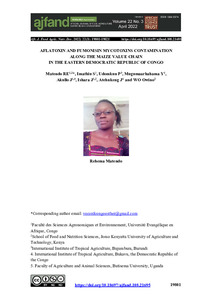| dc.contributor.author | Matendo, R.E. |
| dc.contributor.author | Imathiu, S. |
| dc.contributor.author | Udomkun, P. |
| dc.contributor.author | Mugumaarhahama, Y. |
| dc.contributor.author | Akullo, J. |
| dc.contributor.author | Ishara, J. |
| dc.contributor.author | Atehnkeng, J. |
| dc.contributor.author | Owino, W.O. |
| dc.date.accessioned | 2022-06-08T09:44:58Z |
| dc.date.available | 2022-06-08T09:44:58Z |
| dc.date.issued | 2022-04 |
| dc.identifier.citation | Matendo, R.E., Imathiu, S., Udomkun, P., Mugumaarhahama, Y., Akullo, J., Ishara, J., ... & Owino, W.O. (2022). Aflatoxin and fumonisin mycotoxins contamination along the maize value chain in the eastern Democratic Republic of Congo. African Journal of Food, Agriculture, Nutrition and Development, 22(3), 19801-19821. |
| dc.identifier.issn | 1684-5374 |
| dc.identifier.uri | https://hdl.handle.net/20.500.12478/7498 |
| dc.description.abstract | Aflatoxin and fumonisin contamination was assessed in different samples along the maize value chain in different territories of South Kivu province. Kabare and Ruzizi Plain were chosen as they represent two different agroecological areas where maize is mostly produced. Twelve districts and one town were selected across the province. The stakeholders were randomly selected, and 215 maize (139 maize grain and 76 maize flour) samples were taken for laboratory analysis. The Q + kit was used to determine the total aflatoxins and fumonisins. Three categories of maize were examined: freshly harvested dry maize, stored maize (maize stored for 3 months ±1.5 month) and market maize. Aflatoxin was found in 100% of the maize samples with the least content of 0.3 µg/kg detected in freshly harvested dry maize with mean 3.2+0.3 and levels ranging from 0.3 to 18.5 µg/kg. The average level of aflatoxin in stored grain samples was 97.9±182 µg/kg within a range of 1.16 to 841.5 µg/kg, and the mean level of aflatoxin in stored flour was 148.9±164.5 µg/kg with levels ranging from 2.05 to 905.1 µg/kg. The mean level of aflatoxin maize collected from the market was 95.1 ±164 µg/kg, with levels ranging from 1 to 823.2 µg/kg. Almost all the maize flour collected from the three areas had a high contamination level that exceeded the maximum tolerable limit of 10 µg/kg. Fumonisin was detected in all samples. However, the levels of fumonisin do not follow a specific trend with the duration of storage. The freshly harvested dry maize concentration was 2.4±5.1 µg/g, with levels ranging from 0.03 to 20.9µg/g. About 37% of freshly harvested maize samples contaminated by fumonisin exceeded the maximum tolerable limit of 4 µg/kg. There was a difference between total fumonisin in grain and flour; the average level of fumonisin in stored maize grain was 1.4±0.9 µg/g with levels ranging from 0.18- 4.7 µg/g while in flour, the level was 2.1±1.3 µg/g with levels ranging from 0.3-4.5 µg/g. Almost all the maize samples collected from the three areas had a degree of contamination that did not exceed the maximum tolerable limit of 4 µg/g. These results indicate that the two mycotoxin levels, particularly aflatoxin, were high in the different samples collected at specific nodes. Therefore, preventing mycotoxins accumulation in maize by post-harvest prevention of contamination and growth of toxigenic moulds by promoting proper grain drying and storage should be encouraged among the actors of the maize value chain. |
| dc.description.sponsorship | Global Challenges Research Fund |
| dc.format.extent | 19801-19821 |
| dc.language.iso | en |
| dc.subject | Aflatoxins |
| dc.subject | Fumonisins |
| dc.subject | Value Chain |
| dc.subject | Maize |
| dc.subject | Food Security |
| dc.title | Aflatoxin and fumonisin mycotoxins contamination along the maize value chain in the eastern Democratic Republic of Congo |
| dc.type | Journal Article |
| cg.contributor.crp | Agriculture for Nutrition and Health |
| cg.contributor.affiliation | Université Evangélique en Afrique |
| cg.contributor.affiliation | Jomo Kenyatta University of Agriculture and Technology |
| cg.contributor.affiliation | International Institute of Tropical Agriculture |
| cg.contributor.affiliation | Butisema University |
| cg.coverage.region | Africa |
| cg.coverage.region | Central Africa |
| cg.coverage.country | Democratic Republic of the Congo |
| cg.coverage.hub | Central Africa Hub |
| cg.researchtheme | Nutrition and Human Health |
| cg.researchtheme | Plant Production and Health |
| cg.identifier.bibtexciteid | MATENDO:2022 |
| cg.authorship.types | CGIAR and developing country institute |
| cg.iitasubject | Aflatoxin |
| cg.iitasubject | Agronomy |
| cg.iitasubject | Food Security |
| cg.iitasubject | Maize |
| cg.iitasubject | Plant Breeding |
| cg.iitasubject | Plant Production |
| cg.iitasubject | Value Chains |
| cg.journal | African Journal of Food, Agriculture, Nutrition and Development |
| cg.accessibilitystatus | Open Access |
| cg.reviewstatus | Peer Review |
| cg.usagerightslicense | Creative Commons Attribution-NonCommercial-NoDerivatives 4.0 (CC BY-NC-ND 4.0) |
| cg.targetaudience | Scientists |
| cg.identifier.doi | https://dx.doi.org/10.18697/ajfand.108.21695 |
| cg.iitaauthor.identifier | Patchimaporn Udomkun: 0000-0003-0115-1997 |
| cg.futureupdate.required | No |
| cg.identifier.issue | 3 |
| cg.identifier.volume | 22 |
| cg.contributor.acknowledgements | This work was performed within the International Institute of Tropical Agriculture (IITA), Bukavu and Université Evangélique en Afrique (UEA). Funding for this research was provided by the Social and Environmental Trade-offs in African Agriculture (SENTINEL) of the Global Challenges Research Fund (GCRF)-UK through the Regional Universities Forum for Capacity Building in Agriculture (RUFORUM). |

